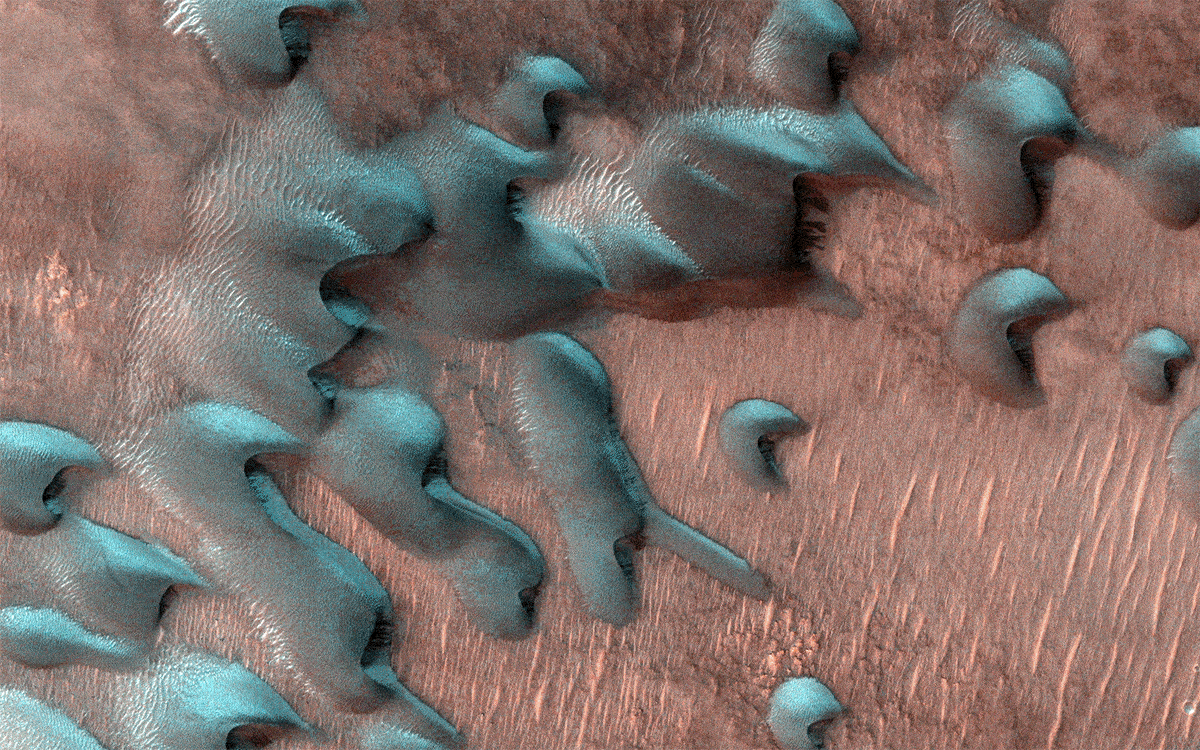
Камера HiRISE на борту Mars Reconnaissance Orbiter NASA зробила ці зображення вкритих інеєм піщаних дюн одразу після зимового сонцестояння. Іній тут є сумішшю вуглекислого газу (сухого) льоду та водяного снігу і зникне через кілька місяців, коли настане весна. Автор зображення: NASA/JPL-Caltech/Університет Арізони
Сніг у формі куба, крижані пейзажі та мороз — все це частина найхолоднішої пори року на Червоній планеті.
Коли приходить зима[{” attribute=””>Mars, the surface is transformed into a truly otherworldly holiday scene. Snow, ice, and frost accompany the season’s sub-zero temperatures. Some of the coldest of these occur at the planet’s poles, where it gets as low as minus 190 degrees Fahrenheit (minus 123 degrees Celsius).
Cold as it is, don’t expect snow drifts worthy of the Rocky Mountains. No region of Mars gets more than a few feet of snow, most of which falls over extremely flat areas. And the Red Planet’s elliptical orbit means it takes many more months for winter to come around: a single Mars year is around two Earth years.
На Марсі також випадає сніг, утворюється лід і іній.[{” attribute=””>NASA’s spacecraft on and orbiting the Red Planet reveal the similarities to and differences from how we experience winter on Earth. Mars scientist Sylvain Piqueux of JPL explains in this video. Credit: NASA/JPL-Caltech
Still, the planet offers unique winter phenomena that scientists have been able to study, thanks to NASA’s robotic Mars explorers. Here are a few of the things they’ve discovered:
Two Kinds of Snow
Martian snow comes in two varieties: water ice and carbon dioxide, or dry ice. Because Martian air is so thin and the temperatures so cold, water-ice snow sublimates, or becomes a gas, before it even touches the ground. Dry-ice snow actually does reach the ground.
“Enough falls that you could snowshoe across it,” said Sylvain Piqueux, a Mars scientist at NASA’s Jet Propulsion Laboratory in Southern California whose research includes a variety of winter phenomena. “If you were looking for skiing, though, you’d have to go into a crater or cliffside, where snow could build up on a sloped surface.”

HiRISE captured these “megadunes,” also called barchans. Carbon dioxide frost and ice have formed over the dunes during the winter; as this starts to sublimate during spring, the darker-colored dune sand is revealed. Credit: NASA/JPL-Caltech/University of Arizona
How We Know It Snows
Snow occurs only at the coldest extremes of Mars: at the poles, under cloud cover, and at night. Cameras on orbiting spacecraft can’t see through those clouds, and surface missions can’t survive in the extreme cold. As a result, no images of falling snow have ever been captured. But scientists know it happens, thanks to a few special science instruments.
NASA’s Mars Reconnaissance Orbiter can peer through cloud cover using its Mars Climate Sounder instrument, which detects light in wavelengths imperceptible to the human eye. That ability has allowed scientists to detect carbon dioxide snow falling to the ground. And in 2008, NASA sent the Phoenix lander within 1,000 miles (about 1,600 kilometers) of Mars’ north pole, where it used a laser instrument to detect water-ice snow falling to the surface.
Вчені NASA можуть вимірювати розмір і форму розподілу частинок снігу шар за шаром під час шторму. Global Precipitation Measurement Mission – це міжнародний супутниковий проект, який забезпечить нове покоління спостереження за дощем і снігом у всьому світі кожні три години. Авторство: Центр космічних польотів імені Годдарда НАСА/Райан Фіцгібонс
кубики льоду
Через те, як молекули води зв’язуються разом, коли вони замерзають, сніжинки на Землі мають шість сторін. Той самий принцип застосовується до всіх кристалів: спосіб організації атомів визначає форму кристала. У випадку вуглекислого газу молекули сухого льоду завжди з’єднуються в чотири форми під час заморожування.
«Оскільки лід із вуглекислим газом має чотири симетрії, ми знаємо, що сухі сніжинки матимуть форму куба», — сказав Біккіо. «Завдяки марсіанському клімату безпечніше, ми можемо сказати, що ці сніжинки будуть меншими за ширину людської волосини».

Камера HiRISE зробила це зображення краю кратера посеред зими. На південному схилі кратера, на який потрапляє менше сонячного світла, утворюється нерівний яскравий іній, показаний синім кольором на цьому покращеному кольоровому зображенні. Автор зображення: NASA/JPL-Caltech/Університет Арізони
Джек Фрост гризе ваш ровер
Як вода, так і вуглекислий газ можуть утворювати іній на Марсі, і обидва типи інею з’являються на планеті ширше, ніж сніг. Під час дослідження Марса в 1970-х роках посадкові апарати «Вікінг» бачили мороз води, а орбітальний апарат НАСА «Одіссей» бачив Спостерігається утворення інею, який сублімується вранішнє сонце.

HiRISE зняв цю весняну сцену, коли водяний лід, вмерзлий у ґрунт, розколов Землю на багатокутники. Прозорий лід із вуглекислого газу дозволяє сонячному світлу проникати крізь нього та нагрівати гази, які просочуються крізь вентиляційні отвори, вистрілюючи віялами темнішого матеріалу на поверхню (показано синім на цьому покращеному кольоровому зображенні). Автор зображення: NASA/JPL-Caltech/Університет Арізони
Дивний кінець зими
Мабуть, найдивовижніше відкриття відбувається наприкінці зими, коли весь утворений лід починає «танути» та сублімується в атмосферу. При цьому цей лід набуває дивних красивих форм, які він нагадує вченим павукиІ Далматинські плямиІ ЯєчняІ швейцарський сир.
Це «танення» також викликає виверження гейзерів: прозорий лід дозволяє сонячному світлу нагрівати газ під ним, і цей газ зрештою вибухає, посилаючи пилові вентилятори на даху. Вчені вже почали вивчати ці вентилятори, щоб дізнатися про них більше У якому напрямку дмуть марсіанські вітри?.

“Професійний вирішувач проблем. Тонко чарівний любитель бекону. Геймер. Завзятий алкогольний ботанік. Музичний трейлер”






